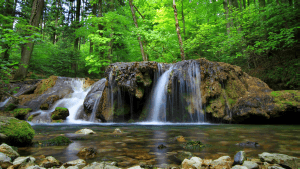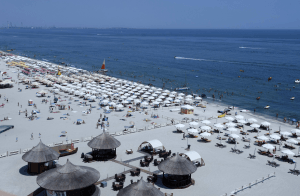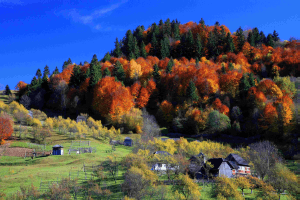Rumänien, einem der faszinierendsten Länder Europas, mit nette, freundliche Leute und schöne Landschaften. Eine kurze Reise ist alles was Sie brauchen, ein kleinen Vorgeschmack auf Rumänien zu bekommen, aber mit so einer Mischung von Geschichte, Legenden, Geheimnisse, die Kultur und Traditionen, Ihren Aufenthalt könnte erweitert sein.
Siebenbürgen: Landleben in Rumänien an seiner verführerischsten, eines der idyllischen Orten in Europa. Besuchen Sie die unberührten Landschaften und die Ruhe von Siebenbürgen mit seinen bekannten sächsischen befestigten Kirchenburgen und Dorfkirchen und mittelalterlichen Burgen, wie Sighisoara, Sibiu und Brasov, alle einen Besuch wert.
Fahren Sie durch den rumänische Dörfer, einen Blick in Rumäniens ländliche Lebensweise und das Gefühl einer echten mittelalterlichen Zeitschleife.
Sie werden durch die Karpaten Hosting seinen berühmten Burgen und Festungen beeindruckt sein von denen Schloss Bran (Dracula-Schloss) und Schloss Peles (das ehemalige Residenz der rumänische Könige) sind nur einige der Schätze Rumäniens.
Und man soll nicht die Donau vergessen, eine der mächtigsten Flüsse unseres Kontinents, die, wenn sie in das Schwarze Meer mündet, ist, Europa zu einer der schönsten natürlichen Gaben schenkt: die Donaudelta.
Alles in allem ist es ein gutes Gefühl, über die moderne Lebens Tempo / Rhythmus zu vergessen und etwas frisches Luft einzuatmen.

1. Tag
Bukarest
Gruppe Empfang von "Henri Coanda" Bukarest Flughafen.
Bukarest war in einer 1459 datierten Urkunde erstmals erwähnt, die wurde von dem Walachei Herrscherr Vlad Țepeș, mit dem Beinamen Draculea, ausgestellt.
Kurze Stadtrundfahrt von Bukarest. Altstadt Besichtigung mit den schonsten Sehenswürdigkeiten in der Lipscani / Innenstadt: Gasthof des Manuc (Hanul lui Manuc), Alter Hof - Ruine des alten Fürstenhofpalastes, Victoriei Boulevard mit dem rumänischen Athenäum - Hauptstadt kulturelles Wahrzeichen, das ehemalige Königspalast, Cantacuzino Palast, Kretzulescu Kirche.
Willkommen-Abendessen in einem schönen historisches Restaurant/ehemalige Bierbrauerei: Der Bier-Wagon (Caru 'cu Bere).
Unterkunft in Bukarest
2. Tag
Bukarest - Curtea de Arges - Sibiu
Transfer von Bukarest, durchs Olt-Tal nach Sibiu, ehemalige Kulturhauptstadt Europas. Besichtigung des Kloster Curtea de Arges, 14. Jh. von Herrscherr Neagoe Basarab gebaut, ein Meisterwerk der rumänischen Architektur und auch ein Ort der Legende: Die Legende des Handwerkers Manole, der seine eigene Ehefrau in den Klostermauern lebendig gebaut hat, als Bedingung für die Kirche für die Ewigkeit zu standen. Konigin Mary von Rumänien, der am meisten geliebte und geheimnisvolle rumänische Königin ist auch neben ihrem Ehemann, Ferdinand I. von Rumänien, in diesem wunderschöne Kloster begraben.
Besichtigung der mittelalterlichen Altstadt von Sibiu, ein gemütliche und faszinierende Stadt mit reizvoller Umgebung, eine der schönsten Städte Rumäniens: der Großer Ring mit Brukenthal-Palais, Haller-Haus, der katholische Kirche und dem Ratturm - Wahrzeichen des Stadtes; Kleiner Ring mit dem Luxemburg-Haus, die Lügenbrücke, dem Haus der Kunst; Huet-Platz mit dem Evangelische Stadtpfarrkirche - deren 67 Grabsteinen (einzigartig in Rumanien) sind jene der ehemaligen Hermannstädter Bürgermeister, und hier befinden sich auch die Grabsteine von Mihnea Vodă cel Rău (dem Sohn von Vlad Tepeş) der wurde auf den Stufen getötet; Sagturm, Sagstiege; Cetatii Straße (Harteneckgasse).
Sibiu ist eine der kulturellen und touristischen Hauptstädten Rumäniens, ein Anziehungspunkt für Touristen wegen seiner wunderbaren mittelalterlichen Charme, mit gut erhaltenen Architektur Denkmäler, schöne Landschaften in der Sibiu Stadtrand, gutes Essen und freundliche Menschen.
Sibiu das größte deutsch-stämmiger Gemeinde in Rumänien enthält.
Abendessen und Übernachtung in Sibiu
* Optional: Abendmenü mit traditionellen und volkstümliche Show im einer Bauernhof in Sibiel (22 km weit von Sibiu) - Hinterglasikonen Museum einzigartig in Europa, mehr als 700 Exponate
Curtea de Arges Monastery
3. Tag
Sibiu - Sighisoara - Cluj-Napoca
Transfer nach Sighisoara, UNESCO Welterbe gelistet, ein kleine befestigte Stadt im Herzen von Siebenbürgen.
Besichtigung der gut erhaltenen Wehranlage und alte Bürgerhäuser: das Eckhaus mit Hirschgeweih, der Stundturm,
Vlad Dracul Geburtshaus, die Bergkirche auf dem Schulberg, der Haus in venezianischer Gotik, die abgedeckten Schülertreppe.
Sighisoara (dt. Schäßburg) ist eine der meistbesuchten Städte in Siebenbürgen, und eine hervorragende Sachsenerbe der lokalen Kultur zeugt. Die am besten erhaltene mittelalterliche Zitadelle in Rumänien bietet Sighisoara ein echtes Gefühl von einer mittelalterlichen Festung, ein besonderes Merkmal ist, dass die Häuser dauerhaft bewohnt waren
Nächster Halt: Cluj-Napoca, die ehemalige Hauptstadt von Siebenbürgen war, und heute eine der lebhaftesten und dynamischsten Städte Rumäniens ist.
Die mittelalterliche Siebenbürgen Hauptstadt, Cluj-Napoca ist heute eine lebendige Stadt, die traditionelle und progressive Veranstaltungen teilt; einen Stadt Besuch ist hervorragende für die kulturelle Aktivitäten, die wunderbare historische Erbe-, Gastronomie- und tolle Atmosphäre wert.
Im Jahr 2015 Cluj-Napoca, "Siebenbürgens Herz", wird die "Europäische Jugendhauptstadt" Titel tragen.
Cluj-Napoca Stadtrundfahrt mit dem Besuch des Gotische St. Michaelskirche, Benediktinerkloster, dem Museumsplatz, dem Unirii Platz/Vereinigungsplatz.
Abendessen und Übernachtung in Cluj-Napoca
Day 4
Cluj Napoca - Turda - Sighetu Marmatiei
Visit of the Turda Salt Mine, one of the oldest and most important salt mines extraction, an activity with old tradition in Transylvania, dating from the XVIIth century; displaying for the tourists old shafts, health and recreational facilities.
Turda Salt Mine (Salina) is an exquisite example of a salt mine transformation into a special facility with a modern approach, a spellbinding place considered ”the coolest underground place in the world”, and also on the 22nd place of the unbelievable travel destinations in the world [Source: “Business Insider”]
Visit of the UNESCO-listed Desesti wooden church, one of the best preserved typical tall wooden churches in Maramures, XVIIIth century dated.
Dinner and accommodation in Sighetu Marmatiei
Day 5
Sighetu Marmatiei – Sapinta - Barsana - Suceava
Leaving Sighetu Marmatiei, the birthplace of Elie Wiesel, 1986 Nobel Peace Prize winner; Transfer to Sapinta, a traditional Romanian village in Maramures county where death is not taken seriously. Visit of the original Merry Cemetery. Famous for its colourful wooden tombstones, depicting episodes of the villagers lives in a naïve manner, the Merry Cemetery represents a genuine chronicle of the rural life.
Passing through the picturesque Iza Valley, well worth visiting for the beautiful landscapes and villages.
Visit of the Barsana (Romanian for Shepherd) wooden church, one of the eight Maramures churches protected by the UNESCO World Heritage list, where you can soak in the tranquility of the site.
The tour continues by leaving Maramures and entering the Bukovina region, with scenic villages, traditional workshops and the famous painted monasteries.
Dinner and accommodation in Suceava
Merry Cemetery, Sapinta, Maramures
Day 6
Suceava - Voronet - Marginea - Suceava
One day dedicated to the beautiful Bukovina region.
Leaving Suceava (former capital of Moldavia during Stefan the Great’s reign), visit of the Voronet church, famous for its stunning XVth - XVIthcentury vivid blue exterior frescoes and the painted Humor monastery, one of the first painted Moldavian monasteries in the XVth century, small but shining bright among Bukovina’s treasures and, along with Voronet, probably the best preserved.
Visit of a traditional pottery workshop in Marginea, a small village preserving a unique and beautiful tradition of producing black ceramics, craftsmanship dating from the XVth century.
Dinner and accommodation in Suceava
Day 7
Suceava - Piatra Neamt - Brasov
Departure from Suceava, transfer to Piatra Neamt, a “green urban island” near the mountains; pass through the spectacular Bicaz Gorges, a narrow path carved into the sheer rocks, one of Romania’s most spectacular roads.
Optional, en route visit of the Neamt fortress, a XIVth century important medieval monument, and Agapia Monastery, an Orthodox nunnery built in the XVIIth century, with its beautiful inside frescoes, created by Nicolae Grigorescu, one of the founders of modern Romanian painting.
Transfer from Moldavia to Brasov, Transylvania.
Brasov (Kronstadt in German, “Crown City”) is surrounded on three sides by the mountains and was founded by the Teutonic Knights in 1211 on an ancient Dacian (Romanian ancestors) site.
It is a remarkable city which hosts Gothic, Baroque, Renaissance architecture, as well as other historical attractions. The marks of the Saxon heritage, are well preserved mainly in the Old Town.
Short city tour with the visit of the City Council Square, the Black Church (Brasov’s landmark, over 500 years old, the largest Gothic church in SE Europe, hosts one of the greatest pipe organs in Europe), Ecaterina's gate, (a fairy-looking medieval tower, part of the last preserved original city gates).
Dinner and accommodation in Brasov/Poiana Brasov
Day 8
Brasov - Sinaia - Bran - Brasov
Transfer to Sinaia mountain resort, the ”Pearl of the Carpathians”.
Visit of the legendary Peles Castle - built like a fairy tale castle, in German Renaissance style, and surrounded by the majestic Carpathian Mts, former residence of Romania's Kings. Built by King Carol I of Romania, (born Prince Karl of Hohenzollern-Sigmaringen dynasty) as his summer residence, Peles Castle shelters a huge collection of works of art, rare furniture, weapons collections, valuable books, and over 2.000 paintings in its 160 rooms.
Lunch & wine tasting (sparkling wines produced using the traditional method) in the "Rhein Azuga" wine cellars, the former supplier of the Romanian Royal Court.
In the afternoon - visit of the Bran Castle, better known as Dracula’s Castle. The medieval stronghold perched on rocks high above the valley was built in the XIVth century, in order to protect the peasants and landowners at the border between the two historical provinces: Walachia and Transylvania. Its mysteries are not all revealed: either the ones surrounding the controversial personality of the real Prince Vlad Tepes/Dracula, or the ones regarding Queen Mary of Romania’s heart covered with a double-faced flag (on one side the Romanian flag, on the other side the English flag) kept in a silver box who temporarily found its peace nearby Bran Castle.
Traditional dinner and accommodation in Brasov/Poiana Brasov
Day 9
Brasov - Tulcea - Danube Delta
Transfer from Brasov in the Dobrogea region (situated between the Danube river and the Black Sea) to Tulcea, an important and ancient harbour, with Byzantine, Genovese, and Ottoman influences, considered to be the entry gate in the Danube Delta.
Leaving Tulcea you will be guided to the selected hotel (by bus/car/boat) in the Danube Delta.
Danube Delta, a World Cultural and Natural Heritage site, a UNESCO protected area is one of Romania’s leading tourism attractions and offers a completely different experience, compared with other European regions, for its travelers. The Danube Delta has the third largest biodiversity in the world and offers a sanctuary for birds, fish, and animals. This natural reservation hosts the largest wetlands in Europe, its unspoiled backwaters host 45 freshwater fish species and 300 migratory & year-round birds, a density unmatched anywhere else in the world, a birdwatchers’ paradise.
Each traveler will have the opportunity to enjoy the tours organized in the Danube Delta: fishing expeditions, bird watching, itinerant tourism, discovery tourism, specialized trips, scientific trips, youth programs tourism, rural tourism, ecotourism, rest & relax tourism, kayak tours.
Dinner and accommodation
* Optional: en route short stop in Ploiesti (in the mid XIXth century the Ploiești region was one of the world's leading oil extraction and refinery sites), and visit of the Clock Museum, sheltering valuable exhibits from the XVIth century till nowadays.
Day 10
Danube Delta
Danube Delta: a special place, Europe’s premier wetlands and best preserved delta is sheltering spectacular wildlife highlights, has been declared a World Cultural & Natural Heritage site and a UNESCO protected area and is one of Romania’s leading attractions.
One full day dedicated to the Danube Delta, includes a 3-4 hours boating on the waterways, and lakes.
The Danube Delta, a sanctuary for birds, fish, and animals, is the third largest biodiversity in the world (over 5,500 flora & fauna species) spreading over 5,050 km2 of marshes, canals, reed islets and lakes.
The Danube Delta shows the well preserved spirit of the locals (“lipoveni”), with the specific fisheries (“cherhanale”) and houses covered with reed roofs, and their traditions: fishing, bees-keeping, gardening and cattle raising, craftsmanship.
The local gastronomy will charm the tourists with the original fish dishes (fish broth, stuffed fish, brines, fish meatballs, fish egg/roe salad, seafood – the best in Romania).
Dinner and accommodation
Day 11
Danube Delta - Bucharest
Transfer from Danube Delta to Bucharest.
Bucharest: visit of the Palace of Parliament, a place full of superlatives: world’s largest civilian building, most expensive administrative building and world’s heaviest building (last entry 15:45).
The Palace of Parliament was designed and its construction started in 1984, during the Ceausescu’s communist regime. Its enormous rooms, halls and galleries are richly decorated with sculptures, golden plasters, intricate ceilings artworks, opulent tapestries and huge carpets, altogether aiming to overwhelm the visitors.
Farewell dinner and accommodation in Bucharest
Day 12
Transfer to "Henri Coanda" Airport, Bucharest.
Goodbye Romania !
 Rumänien Rundreisen
Rumänien Rundreisen Rumänien & Nachbarländer
Rumänien & Nachbarländer Besondere Interessen
Besondere Interessen Wochenendreise
Wochenendreise
 Autorundreisen
Autorundreisen









.png)





















































































Kommentar hinzufügen